ILM Level 3: Communication Process and Workplace Strategies
VerifiedAdded on 2023/02/01
|15
|2783
|96
Homework Assignment
AI Summary
This assignment explores the nature and importance of the communication process in the workplace. It defines communication, explains its significance for staff and customers, and describes the communication cycle based on the Shannon & Weaver model, identifying potential problems. The assignment also identifies and analyzes various barriers to communication, including channel, language, technical, feedback, and cultural barriers, providing strategies to overcome them. It further details the main methods of written and oral communication, their advantages, and disadvantages, including the influence of non-verbal communication and the value of feedback. Additionally, the assignment includes a piece of business writing, adhering to organizational conventions, and assesses the student's own communication effectiveness through self-assessment and feedback from others. The assignment covers team leadership development and communication strategies within an organizational context.

Paraphrase This Document
Need a fresh take? Get an instant paraphrase of this document with our AI Paraphraser


⊘ This is a preview!⊘
Do you want full access?
Subscribe today to unlock all pages.

Trusted by 1+ million students worldwide

Paraphrase This Document
Need a fresh take? Get an instant paraphrase of this document with our AI Paraphraser

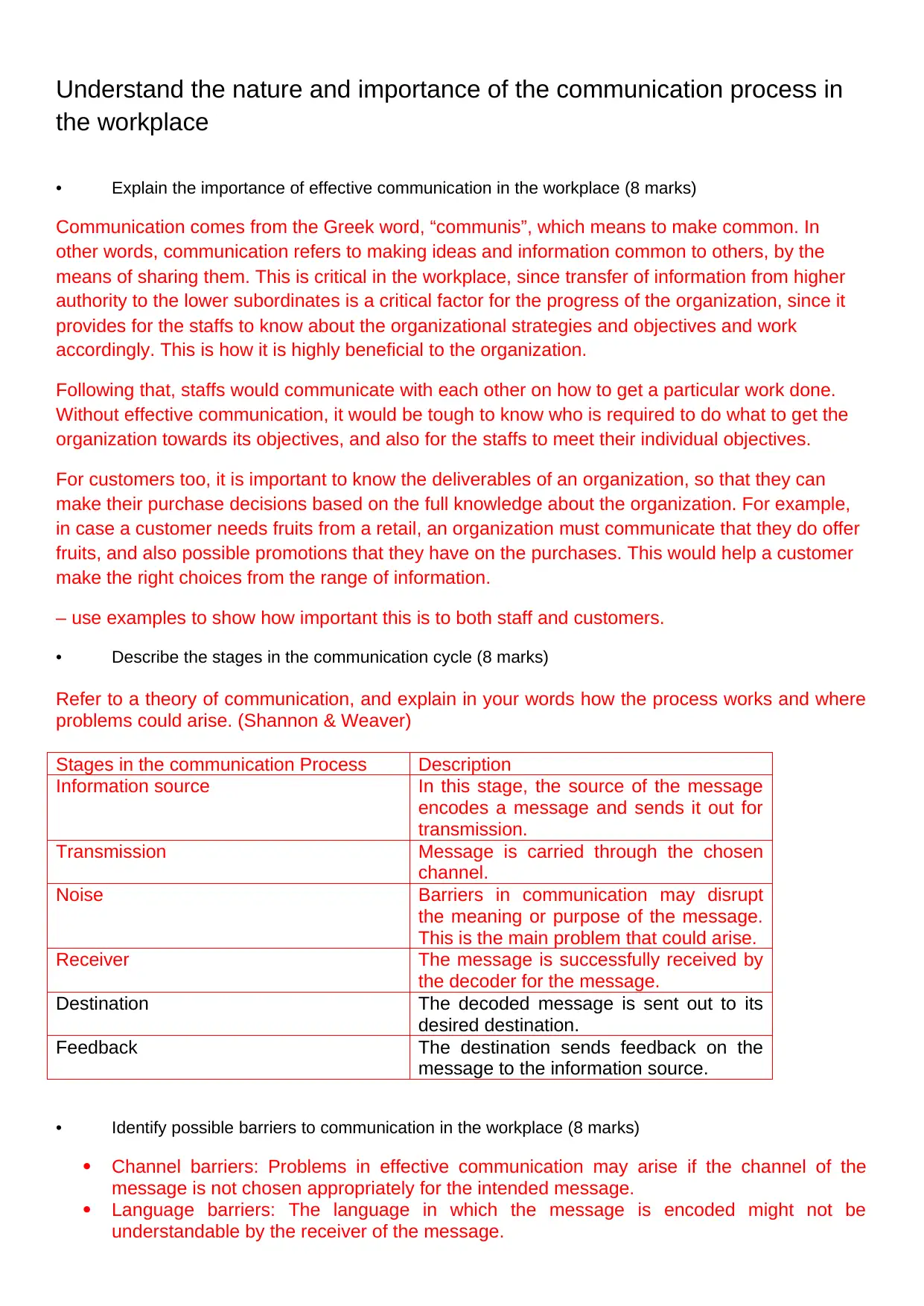
Understand the nature and importance of the communication process in
the workplace
• Explain the importance of effective communication in the workplace (8 marks)
Communication comes from the Greek word, “communis”, which means to make common. In
other words, communication refers to making ideas and information common to others, by the
means of sharing them. This is critical in the workplace, since transfer of information from higher
authority to the lower subordinates is a critical factor for the progress of the organization, since it
provides for the staffs to know about the organizational strategies and objectives and work
accordingly. This is how it is highly beneficial to the organization.
Following that, staffs would communicate with each other on how to get a particular work done.
Without effective communication, it would be tough to know who is required to do what to get the
organization towards its objectives, and also for the staffs to meet their individual objectives.
For customers too, it is important to know the deliverables of an organization, so that they can
make their purchase decisions based on the full knowledge about the organization. For example,
in case a customer needs fruits from a retail, an organization must communicate that they do offer
fruits, and also possible promotions that they have on the purchases. This would help a customer
make the right choices from the range of information.
– use examples to show how important this is to both staff and customers.
• Describe the stages in the communication cycle (8 marks)
Refer to a theory of communication, and explain in your words how the process works and where
problems could arise. (Shannon & Weaver)
Stages in the communication Process Description
Information source In this stage, the source of the message
encodes a message and sends it out for
transmission.
Transmission Message is carried through the chosen
channel.
Noise Barriers in communication may disrupt
the meaning or purpose of the message.
This is the main problem that could arise.
Receiver The message is successfully received by
the decoder for the message.
Destination The decoded message is sent out to its
desired destination.
Feedback The destination sends feedback on the
message to the information source.
• Identify possible barriers to communication in the workplace (8 marks)
Channel barriers: Problems in effective communication may arise if the channel of the
message is not chosen appropriately for the intended message.
Language barriers: The language in which the message is encoded might not be
understandable by the receiver of the message.
the workplace
• Explain the importance of effective communication in the workplace (8 marks)
Communication comes from the Greek word, “communis”, which means to make common. In
other words, communication refers to making ideas and information common to others, by the
means of sharing them. This is critical in the workplace, since transfer of information from higher
authority to the lower subordinates is a critical factor for the progress of the organization, since it
provides for the staffs to know about the organizational strategies and objectives and work
accordingly. This is how it is highly beneficial to the organization.
Following that, staffs would communicate with each other on how to get a particular work done.
Without effective communication, it would be tough to know who is required to do what to get the
organization towards its objectives, and also for the staffs to meet their individual objectives.
For customers too, it is important to know the deliverables of an organization, so that they can
make their purchase decisions based on the full knowledge about the organization. For example,
in case a customer needs fruits from a retail, an organization must communicate that they do offer
fruits, and also possible promotions that they have on the purchases. This would help a customer
make the right choices from the range of information.
– use examples to show how important this is to both staff and customers.
• Describe the stages in the communication cycle (8 marks)
Refer to a theory of communication, and explain in your words how the process works and where
problems could arise. (Shannon & Weaver)
Stages in the communication Process Description
Information source In this stage, the source of the message
encodes a message and sends it out for
transmission.
Transmission Message is carried through the chosen
channel.
Noise Barriers in communication may disrupt
the meaning or purpose of the message.
This is the main problem that could arise.
Receiver The message is successfully received by
the decoder for the message.
Destination The decoded message is sent out to its
desired destination.
Feedback The destination sends feedback on the
message to the information source.
• Identify possible barriers to communication in the workplace (8 marks)
Channel barriers: Problems in effective communication may arise if the channel of the
message is not chosen appropriately for the intended message.
Language barriers: The language in which the message is encoded might not be
understandable by the receiver of the message.
⊘ This is a preview!⊘
Do you want full access?
Subscribe today to unlock all pages.

Trusted by 1+ million students worldwide
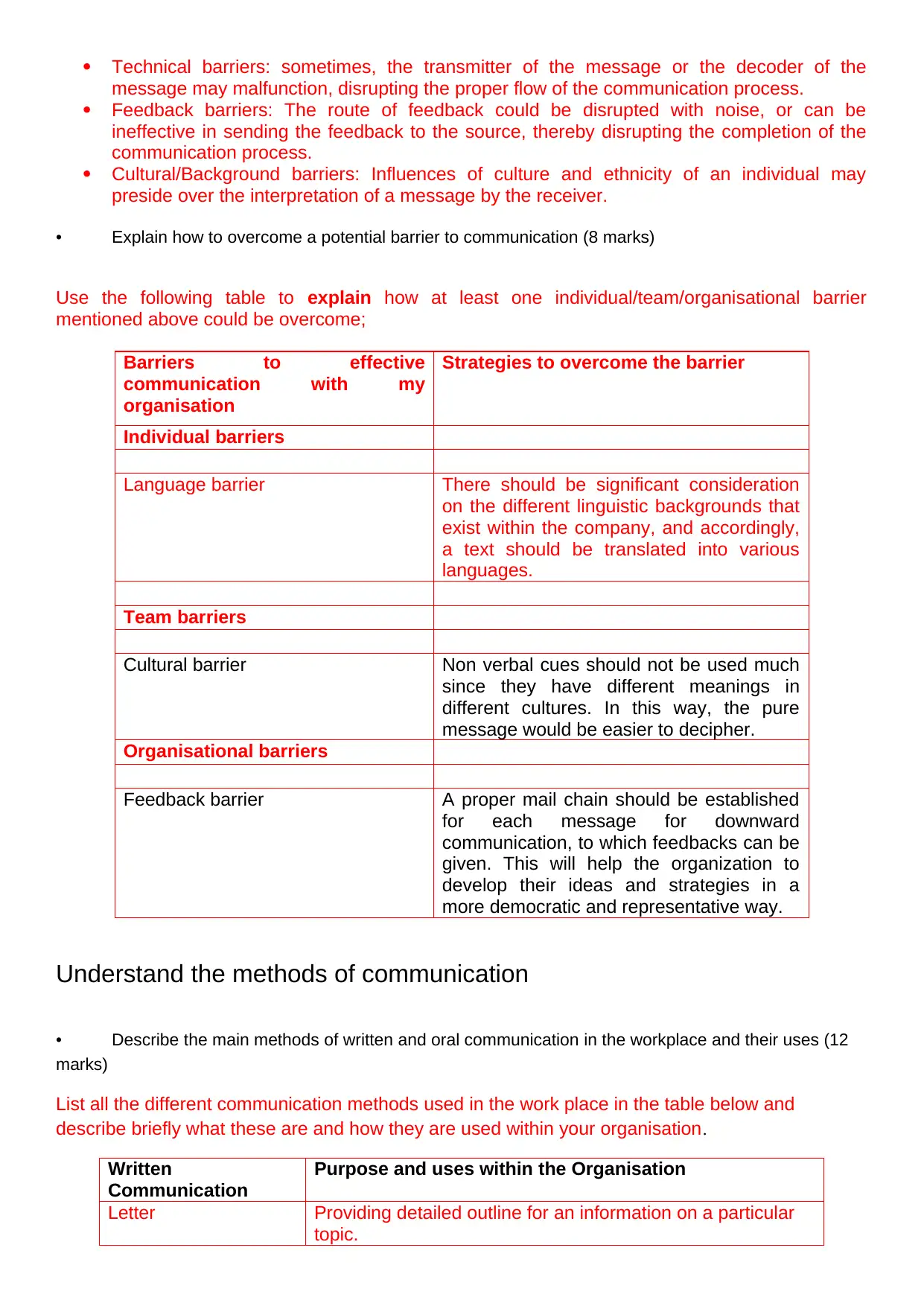
Technical barriers: sometimes, the transmitter of the message or the decoder of the
message may malfunction, disrupting the proper flow of the communication process.
Feedback barriers: The route of feedback could be disrupted with noise, or can be
ineffective in sending the feedback to the source, thereby disrupting the completion of the
communication process.
Cultural/Background barriers: Influences of culture and ethnicity of an individual may
preside over the interpretation of a message by the receiver.
• Explain how to overcome a potential barrier to communication (8 marks)
Use the following table to explain how at least one individual/team/organisational barrier
mentioned above could be overcome;
Barriers to effective
communication with my
organisation
Strategies to overcome the barrier
Individual barriers
Language barrier There should be significant consideration
on the different linguistic backgrounds that
exist within the company, and accordingly,
a text should be translated into various
languages.
Team barriers
Cultural barrier Non verbal cues should not be used much
since they have different meanings in
different cultures. In this way, the pure
message would be easier to decipher.
Organisational barriers
Feedback barrier A proper mail chain should be established
for each message for downward
communication, to which feedbacks can be
given. This will help the organization to
develop their ideas and strategies in a
more democratic and representative way.
Understand the methods of communication
• Describe the main methods of written and oral communication in the workplace and their uses (12
marks)
List all the different communication methods used in the work place in the table below and
describe briefly what these are and how they are used within your organisation.
Written
Communication
Purpose and uses within the Organisation
Letter Providing detailed outline for an information on a particular
topic.
message may malfunction, disrupting the proper flow of the communication process.
Feedback barriers: The route of feedback could be disrupted with noise, or can be
ineffective in sending the feedback to the source, thereby disrupting the completion of the
communication process.
Cultural/Background barriers: Influences of culture and ethnicity of an individual may
preside over the interpretation of a message by the receiver.
• Explain how to overcome a potential barrier to communication (8 marks)
Use the following table to explain how at least one individual/team/organisational barrier
mentioned above could be overcome;
Barriers to effective
communication with my
organisation
Strategies to overcome the barrier
Individual barriers
Language barrier There should be significant consideration
on the different linguistic backgrounds that
exist within the company, and accordingly,
a text should be translated into various
languages.
Team barriers
Cultural barrier Non verbal cues should not be used much
since they have different meanings in
different cultures. In this way, the pure
message would be easier to decipher.
Organisational barriers
Feedback barrier A proper mail chain should be established
for each message for downward
communication, to which feedbacks can be
given. This will help the organization to
develop their ideas and strategies in a
more democratic and representative way.
Understand the methods of communication
• Describe the main methods of written and oral communication in the workplace and their uses (12
marks)
List all the different communication methods used in the work place in the table below and
describe briefly what these are and how they are used within your organisation.
Written
Communication
Purpose and uses within the Organisation
Letter Providing detailed outline for an information on a particular
topic.
Paraphrase This Document
Need a fresh take? Get an instant paraphrase of this document with our AI Paraphraser
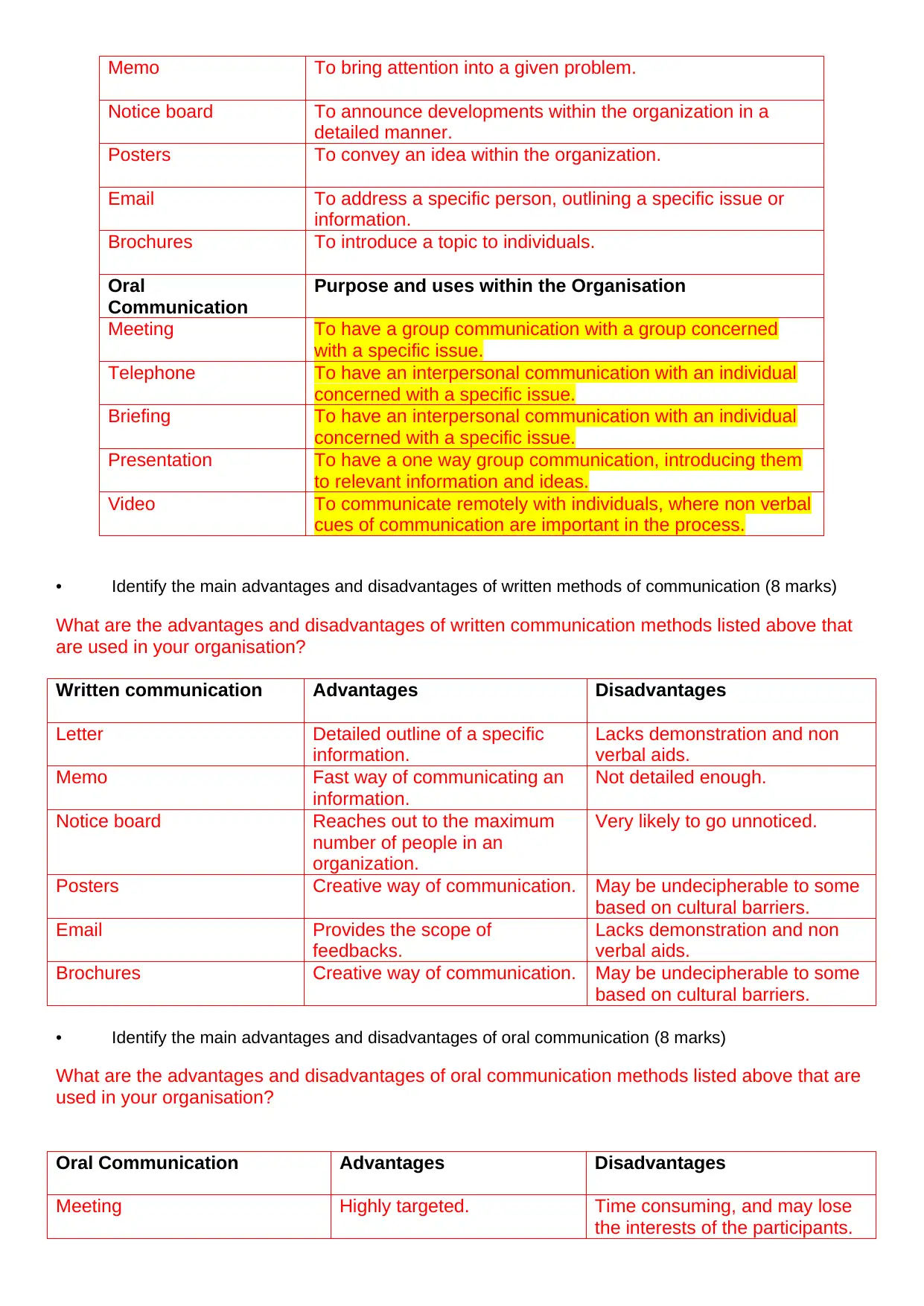
Memo To bring attention into a given problem.
Notice board To announce developments within the organization in a
detailed manner.
Posters To convey an idea within the organization.
Email To address a specific person, outlining a specific issue or
information.
Brochures To introduce a topic to individuals.
Oral
Communication
Purpose and uses within the Organisation
Meeting To have a group communication with a group concerned
with a specific issue.
Telephone To have an interpersonal communication with an individual
concerned with a specific issue.
Briefing To have an interpersonal communication with an individual
concerned with a specific issue.
Presentation To have a one way group communication, introducing them
to relevant information and ideas.
Video To communicate remotely with individuals, where non verbal
cues of communication are important in the process.
• Identify the main advantages and disadvantages of written methods of communication (8 marks)
What are the advantages and disadvantages of written communication methods listed above that
are used in your organisation?
Written communication Advantages Disadvantages
Letter Detailed outline of a specific
information.
Lacks demonstration and non
verbal aids.
Memo Fast way of communicating an
information.
Not detailed enough.
Notice board Reaches out to the maximum
number of people in an
organization.
Very likely to go unnoticed.
Posters Creative way of communication. May be undecipherable to some
based on cultural barriers.
Email Provides the scope of
feedbacks.
Lacks demonstration and non
verbal aids.
Brochures Creative way of communication. May be undecipherable to some
based on cultural barriers.
• Identify the main advantages and disadvantages of oral communication (8 marks)
What are the advantages and disadvantages of oral communication methods listed above that are
used in your organisation?
Oral Communication Advantages Disadvantages
Meeting Highly targeted. Time consuming, and may lose
the interests of the participants.
Notice board To announce developments within the organization in a
detailed manner.
Posters To convey an idea within the organization.
Email To address a specific person, outlining a specific issue or
information.
Brochures To introduce a topic to individuals.
Oral
Communication
Purpose and uses within the Organisation
Meeting To have a group communication with a group concerned
with a specific issue.
Telephone To have an interpersonal communication with an individual
concerned with a specific issue.
Briefing To have an interpersonal communication with an individual
concerned with a specific issue.
Presentation To have a one way group communication, introducing them
to relevant information and ideas.
Video To communicate remotely with individuals, where non verbal
cues of communication are important in the process.
• Identify the main advantages and disadvantages of written methods of communication (8 marks)
What are the advantages and disadvantages of written communication methods listed above that
are used in your organisation?
Written communication Advantages Disadvantages
Letter Detailed outline of a specific
information.
Lacks demonstration and non
verbal aids.
Memo Fast way of communicating an
information.
Not detailed enough.
Notice board Reaches out to the maximum
number of people in an
organization.
Very likely to go unnoticed.
Posters Creative way of communication. May be undecipherable to some
based on cultural barriers.
Email Provides the scope of
feedbacks.
Lacks demonstration and non
verbal aids.
Brochures Creative way of communication. May be undecipherable to some
based on cultural barriers.
• Identify the main advantages and disadvantages of oral communication (8 marks)
What are the advantages and disadvantages of oral communication methods listed above that are
used in your organisation?
Oral Communication Advantages Disadvantages
Meeting Highly targeted. Time consuming, and may lose
the interests of the participants.
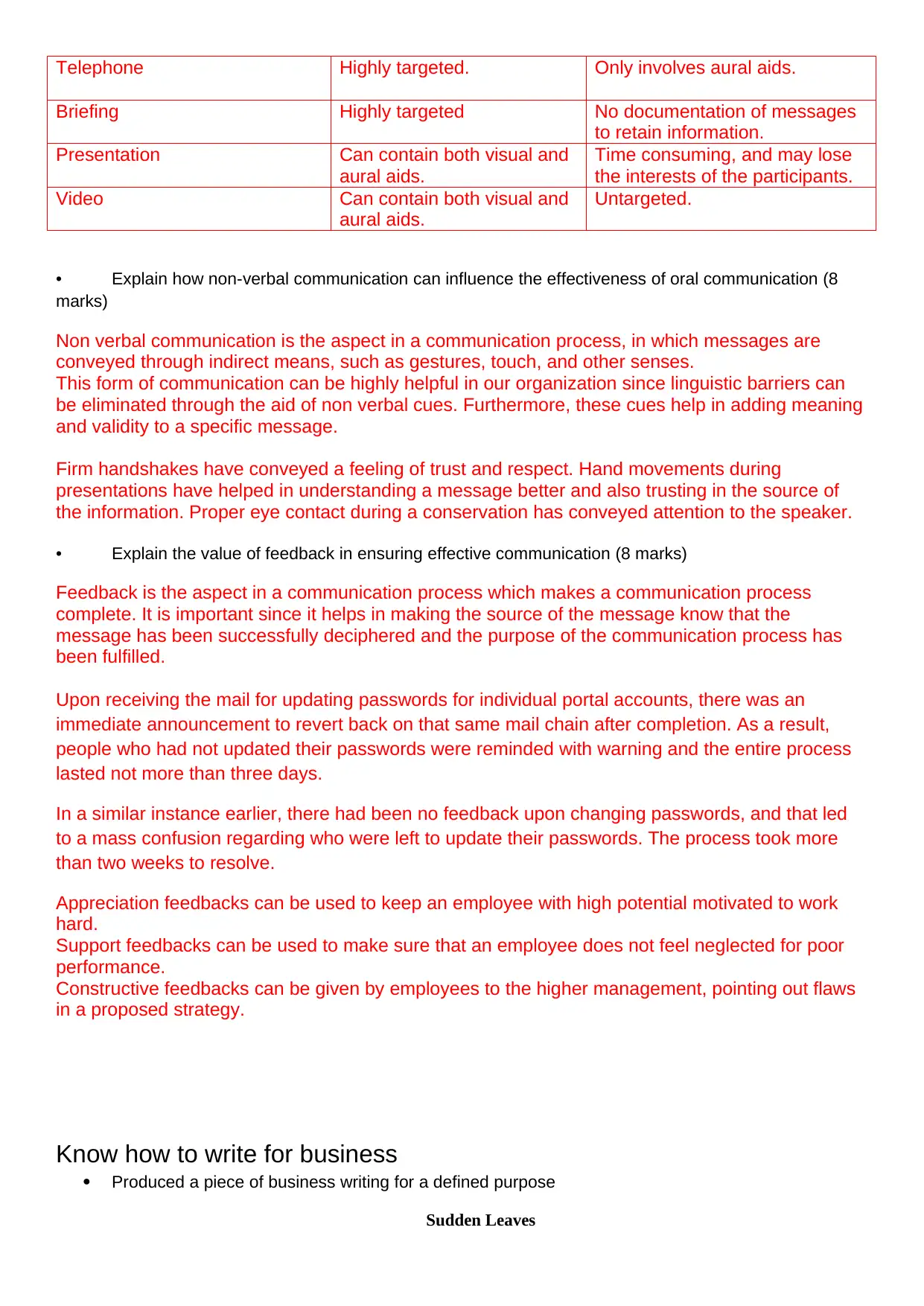
Telephone Highly targeted. Only involves aural aids.
Briefing Highly targeted No documentation of messages
to retain information.
Presentation Can contain both visual and
aural aids.
Time consuming, and may lose
the interests of the participants.
Video Can contain both visual and
aural aids.
Untargeted.
• Explain how non-verbal communication can influence the effectiveness of oral communication (8
marks)
Non verbal communication is the aspect in a communication process, in which messages are
conveyed through indirect means, such as gestures, touch, and other senses.
This form of communication can be highly helpful in our organization since linguistic barriers can
be eliminated through the aid of non verbal cues. Furthermore, these cues help in adding meaning
and validity to a specific message.
Firm handshakes have conveyed a feeling of trust and respect. Hand movements during
presentations have helped in understanding a message better and also trusting in the source of
the information. Proper eye contact during a conservation has conveyed attention to the speaker.
• Explain the value of feedback in ensuring effective communication (8 marks)
Feedback is the aspect in a communication process which makes a communication process
complete. It is important since it helps in making the source of the message know that the
message has been successfully deciphered and the purpose of the communication process has
been fulfilled.
Upon receiving the mail for updating passwords for individual portal accounts, there was an
immediate announcement to revert back on that same mail chain after completion. As a result,
people who had not updated their passwords were reminded with warning and the entire process
lasted not more than three days.
In a similar instance earlier, there had been no feedback upon changing passwords, and that led
to a mass confusion regarding who were left to update their passwords. The process took more
than two weeks to resolve.
Appreciation feedbacks can be used to keep an employee with high potential motivated to work
hard.
Support feedbacks can be used to make sure that an employee does not feel neglected for poor
performance.
Constructive feedbacks can be given by employees to the higher management, pointing out flaws
in a proposed strategy.
Know how to write for business
Produced a piece of business writing for a defined purpose
Sudden Leaves
Briefing Highly targeted No documentation of messages
to retain information.
Presentation Can contain both visual and
aural aids.
Time consuming, and may lose
the interests of the participants.
Video Can contain both visual and
aural aids.
Untargeted.
• Explain how non-verbal communication can influence the effectiveness of oral communication (8
marks)
Non verbal communication is the aspect in a communication process, in which messages are
conveyed through indirect means, such as gestures, touch, and other senses.
This form of communication can be highly helpful in our organization since linguistic barriers can
be eliminated through the aid of non verbal cues. Furthermore, these cues help in adding meaning
and validity to a specific message.
Firm handshakes have conveyed a feeling of trust and respect. Hand movements during
presentations have helped in understanding a message better and also trusting in the source of
the information. Proper eye contact during a conservation has conveyed attention to the speaker.
• Explain the value of feedback in ensuring effective communication (8 marks)
Feedback is the aspect in a communication process which makes a communication process
complete. It is important since it helps in making the source of the message know that the
message has been successfully deciphered and the purpose of the communication process has
been fulfilled.
Upon receiving the mail for updating passwords for individual portal accounts, there was an
immediate announcement to revert back on that same mail chain after completion. As a result,
people who had not updated their passwords were reminded with warning and the entire process
lasted not more than three days.
In a similar instance earlier, there had been no feedback upon changing passwords, and that led
to a mass confusion regarding who were left to update their passwords. The process took more
than two weeks to resolve.
Appreciation feedbacks can be used to keep an employee with high potential motivated to work
hard.
Support feedbacks can be used to make sure that an employee does not feel neglected for poor
performance.
Constructive feedbacks can be given by employees to the higher management, pointing out flaws
in a proposed strategy.
Know how to write for business
Produced a piece of business writing for a defined purpose
Sudden Leaves
⊘ This is a preview!⊘
Do you want full access?
Subscribe today to unlock all pages.

Trusted by 1+ million students worldwide
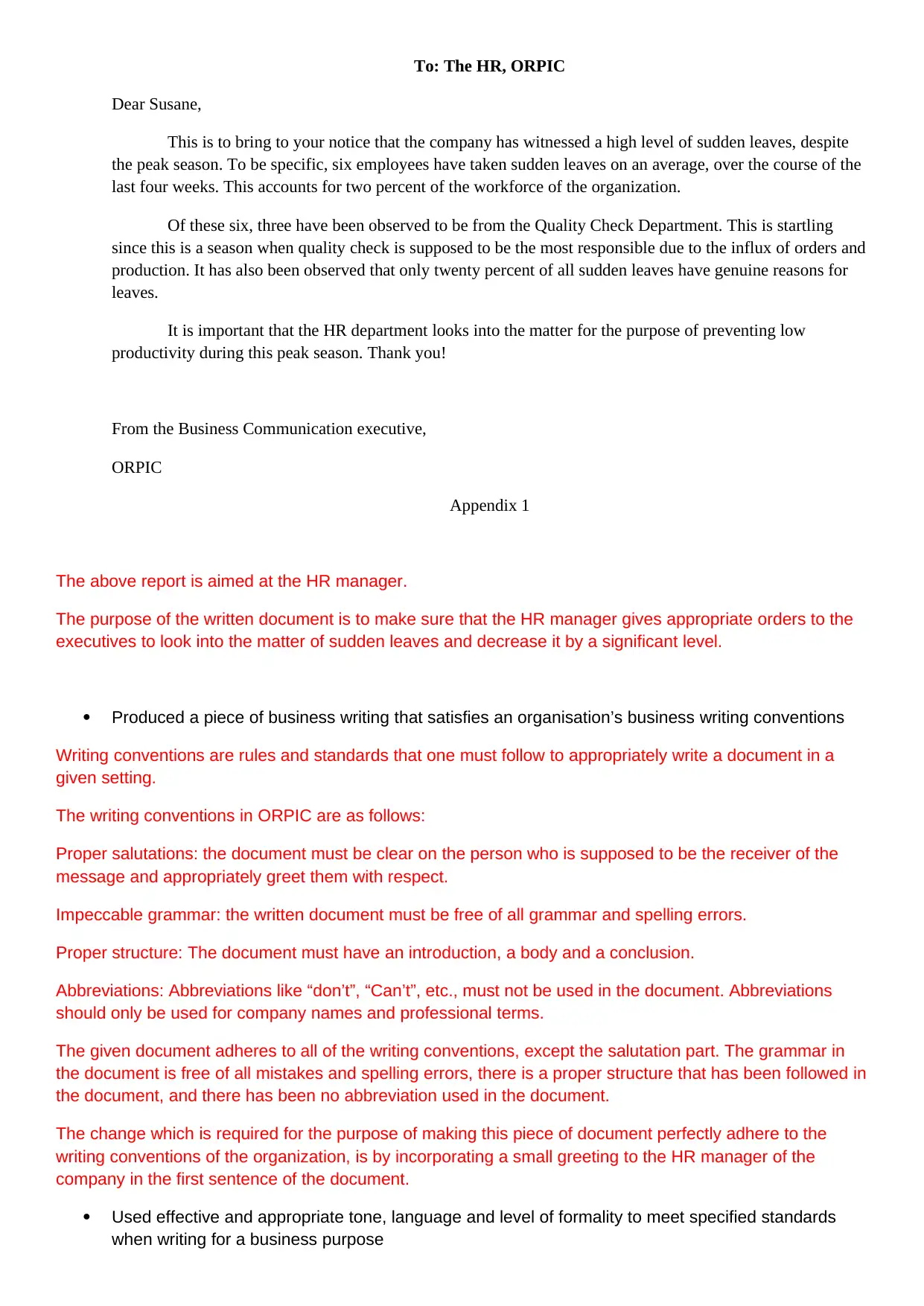
To: The HR, ORPIC
Dear Susane,
This is to bring to your notice that the company has witnessed a high level of sudden leaves, despite
the peak season. To be specific, six employees have taken sudden leaves on an average, over the course of the
last four weeks. This accounts for two percent of the workforce of the organization.
Of these six, three have been observed to be from the Quality Check Department. This is startling
since this is a season when quality check is supposed to be the most responsible due to the influx of orders and
production. It has also been observed that only twenty percent of all sudden leaves have genuine reasons for
leaves.
It is important that the HR department looks into the matter for the purpose of preventing low
productivity during this peak season. Thank you!
From the Business Communication executive,
ORPIC
Appendix 1
The above report is aimed at the HR manager.
The purpose of the written document is to make sure that the HR manager gives appropriate orders to the
executives to look into the matter of sudden leaves and decrease it by a significant level.
Produced a piece of business writing that satisfies an organisation’s business writing conventions
Writing conventions are rules and standards that one must follow to appropriately write a document in a
given setting.
The writing conventions in ORPIC are as follows:
Proper salutations: the document must be clear on the person who is supposed to be the receiver of the
message and appropriately greet them with respect.
Impeccable grammar: the written document must be free of all grammar and spelling errors.
Proper structure: The document must have an introduction, a body and a conclusion.
Abbreviations: Abbreviations like “don’t”, “Can’t”, etc., must not be used in the document. Abbreviations
should only be used for company names and professional terms.
The given document adheres to all of the writing conventions, except the salutation part. The grammar in
the document is free of all mistakes and spelling errors, there is a proper structure that has been followed in
the document, and there has been no abbreviation used in the document.
The change which is required for the purpose of making this piece of document perfectly adhere to the
writing conventions of the organization, is by incorporating a small greeting to the HR manager of the
company in the first sentence of the document.
Used effective and appropriate tone, language and level of formality to meet specified standards
when writing for a business purpose
Dear Susane,
This is to bring to your notice that the company has witnessed a high level of sudden leaves, despite
the peak season. To be specific, six employees have taken sudden leaves on an average, over the course of the
last four weeks. This accounts for two percent of the workforce of the organization.
Of these six, three have been observed to be from the Quality Check Department. This is startling
since this is a season when quality check is supposed to be the most responsible due to the influx of orders and
production. It has also been observed that only twenty percent of all sudden leaves have genuine reasons for
leaves.
It is important that the HR department looks into the matter for the purpose of preventing low
productivity during this peak season. Thank you!
From the Business Communication executive,
ORPIC
Appendix 1
The above report is aimed at the HR manager.
The purpose of the written document is to make sure that the HR manager gives appropriate orders to the
executives to look into the matter of sudden leaves and decrease it by a significant level.
Produced a piece of business writing that satisfies an organisation’s business writing conventions
Writing conventions are rules and standards that one must follow to appropriately write a document in a
given setting.
The writing conventions in ORPIC are as follows:
Proper salutations: the document must be clear on the person who is supposed to be the receiver of the
message and appropriately greet them with respect.
Impeccable grammar: the written document must be free of all grammar and spelling errors.
Proper structure: The document must have an introduction, a body and a conclusion.
Abbreviations: Abbreviations like “don’t”, “Can’t”, etc., must not be used in the document. Abbreviations
should only be used for company names and professional terms.
The given document adheres to all of the writing conventions, except the salutation part. The grammar in
the document is free of all mistakes and spelling errors, there is a proper structure that has been followed in
the document, and there has been no abbreviation used in the document.
The change which is required for the purpose of making this piece of document perfectly adhere to the
writing conventions of the organization, is by incorporating a small greeting to the HR manager of the
company in the first sentence of the document.
Used effective and appropriate tone, language and level of formality to meet specified standards
when writing for a business purpose
Paraphrase This Document
Need a fresh take? Get an instant paraphrase of this document with our AI Paraphraser
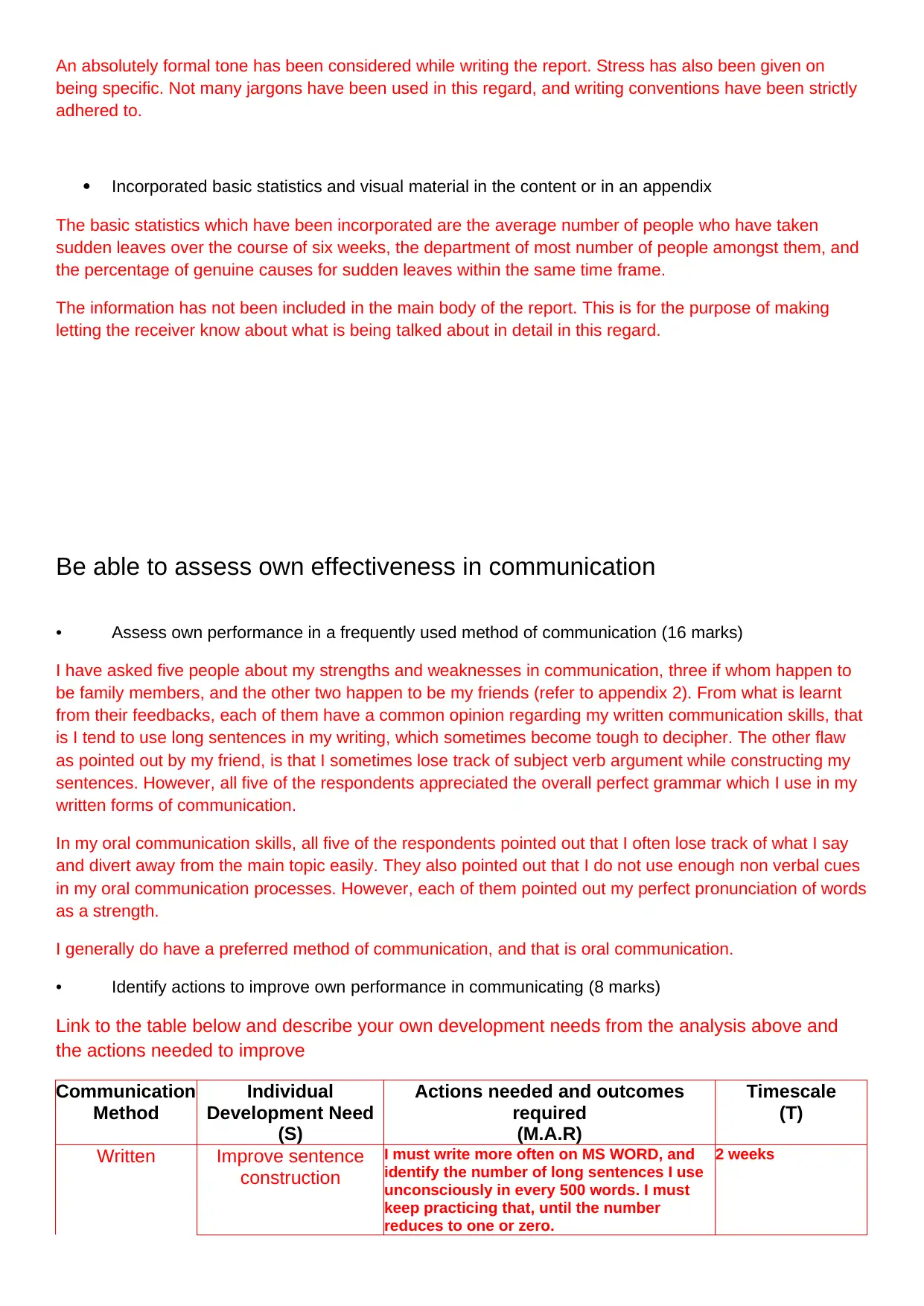
An absolutely formal tone has been considered while writing the report. Stress has also been given on
being specific. Not many jargons have been used in this regard, and writing conventions have been strictly
adhered to.
Incorporated basic statistics and visual material in the content or in an appendix
The basic statistics which have been incorporated are the average number of people who have taken
sudden leaves over the course of six weeks, the department of most number of people amongst them, and
the percentage of genuine causes for sudden leaves within the same time frame.
The information has not been included in the main body of the report. This is for the purpose of making
letting the receiver know about what is being talked about in detail in this regard.
Be able to assess own effectiveness in communication
• Assess own performance in a frequently used method of communication (16 marks)
I have asked five people about my strengths and weaknesses in communication, three if whom happen to
be family members, and the other two happen to be my friends (refer to appendix 2). From what is learnt
from their feedbacks, each of them have a common opinion regarding my written communication skills, that
is I tend to use long sentences in my writing, which sometimes become tough to decipher. The other flaw
as pointed out by my friend, is that I sometimes lose track of subject verb argument while constructing my
sentences. However, all five of the respondents appreciated the overall perfect grammar which I use in my
written forms of communication.
In my oral communication skills, all five of the respondents pointed out that I often lose track of what I say
and divert away from the main topic easily. They also pointed out that I do not use enough non verbal cues
in my oral communication processes. However, each of them pointed out my perfect pronunciation of words
as a strength.
I generally do have a preferred method of communication, and that is oral communication.
• Identify actions to improve own performance in communicating (8 marks)
Link to the table below and describe your own development needs from the analysis above and
the actions needed to improve
Communication
Method
Individual
Development Need
(S)
Actions needed and outcomes
required
(M.A.R)
Timescale
(T)
Written Improve sentence
construction
I must write more often on MS WORD, and
identify the number of long sentences I use
unconsciously in every 500 words. I must
keep practicing that, until the number
reduces to one or zero.
2 weeks
being specific. Not many jargons have been used in this regard, and writing conventions have been strictly
adhered to.
Incorporated basic statistics and visual material in the content or in an appendix
The basic statistics which have been incorporated are the average number of people who have taken
sudden leaves over the course of six weeks, the department of most number of people amongst them, and
the percentage of genuine causes for sudden leaves within the same time frame.
The information has not been included in the main body of the report. This is for the purpose of making
letting the receiver know about what is being talked about in detail in this regard.
Be able to assess own effectiveness in communication
• Assess own performance in a frequently used method of communication (16 marks)
I have asked five people about my strengths and weaknesses in communication, three if whom happen to
be family members, and the other two happen to be my friends (refer to appendix 2). From what is learnt
from their feedbacks, each of them have a common opinion regarding my written communication skills, that
is I tend to use long sentences in my writing, which sometimes become tough to decipher. The other flaw
as pointed out by my friend, is that I sometimes lose track of subject verb argument while constructing my
sentences. However, all five of the respondents appreciated the overall perfect grammar which I use in my
written forms of communication.
In my oral communication skills, all five of the respondents pointed out that I often lose track of what I say
and divert away from the main topic easily. They also pointed out that I do not use enough non verbal cues
in my oral communication processes. However, each of them pointed out my perfect pronunciation of words
as a strength.
I generally do have a preferred method of communication, and that is oral communication.
• Identify actions to improve own performance in communicating (8 marks)
Link to the table below and describe your own development needs from the analysis above and
the actions needed to improve
Communication
Method
Individual
Development Need
(S)
Actions needed and outcomes
required
(M.A.R)
Timescale
(T)
Written Improve sentence
construction
I must write more often on MS WORD, and
identify the number of long sentences I use
unconsciously in every 500 words. I must
keep practicing that, until the number
reduces to one or zero.
2 weeks
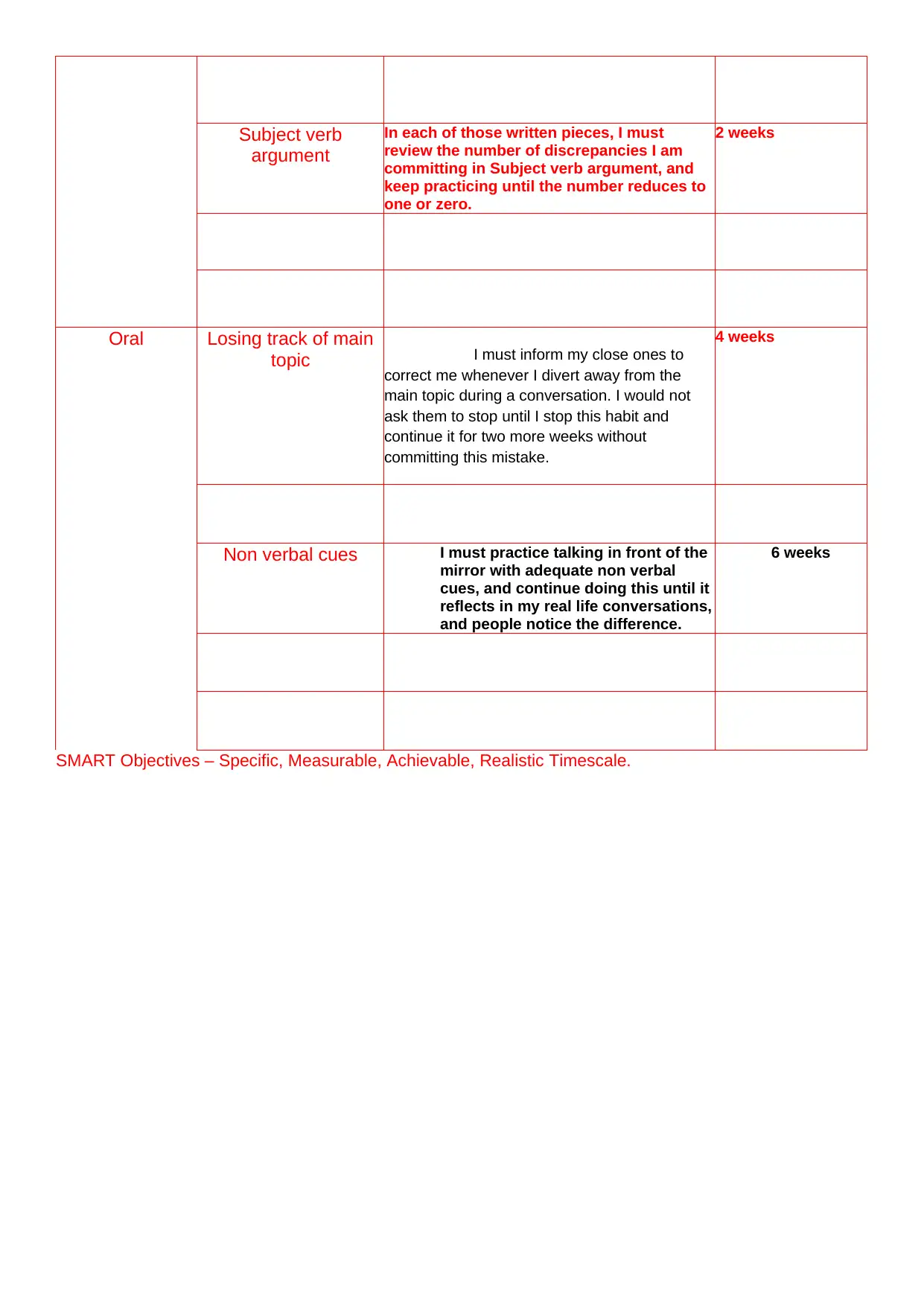
Subject verb
argument
In each of those written pieces, I must
review the number of discrepancies I am
committing in Subject verb argument, and
keep practicing until the number reduces to
one or zero.
2 weeks
Oral Losing track of main
topic I must inform my close ones to
correct me whenever I divert away from the
main topic during a conversation. I would not
ask them to stop until I stop this habit and
continue it for two more weeks without
committing this mistake.
4 weeks
Non verbal cues I must practice talking in front of the
mirror with adequate non verbal
cues, and continue doing this until it
reflects in my real life conversations,
and people notice the difference.
6 weeks
SMART Objectives – Specific, Measurable, Achievable, Realistic Timescale.
argument
In each of those written pieces, I must
review the number of discrepancies I am
committing in Subject verb argument, and
keep practicing until the number reduces to
one or zero.
2 weeks
Oral Losing track of main
topic I must inform my close ones to
correct me whenever I divert away from the
main topic during a conversation. I would not
ask them to stop until I stop this habit and
continue it for two more weeks without
committing this mistake.
4 weeks
Non verbal cues I must practice talking in front of the
mirror with adequate non verbal
cues, and continue doing this until it
reflects in my real life conversations,
and people notice the difference.
6 weeks
SMART Objectives – Specific, Measurable, Achievable, Realistic Timescale.
⊘ This is a preview!⊘
Do you want full access?
Subscribe today to unlock all pages.

Trusted by 1+ million students worldwide
1 out of 15
Related Documents
Your All-in-One AI-Powered Toolkit for Academic Success.
+13062052269
info@desklib.com
Available 24*7 on WhatsApp / Email
![[object Object]](/_next/static/media/star-bottom.7253800d.svg)
Unlock your academic potential
Copyright © 2020–2025 A2Z Services. All Rights Reserved. Developed and managed by ZUCOL.





